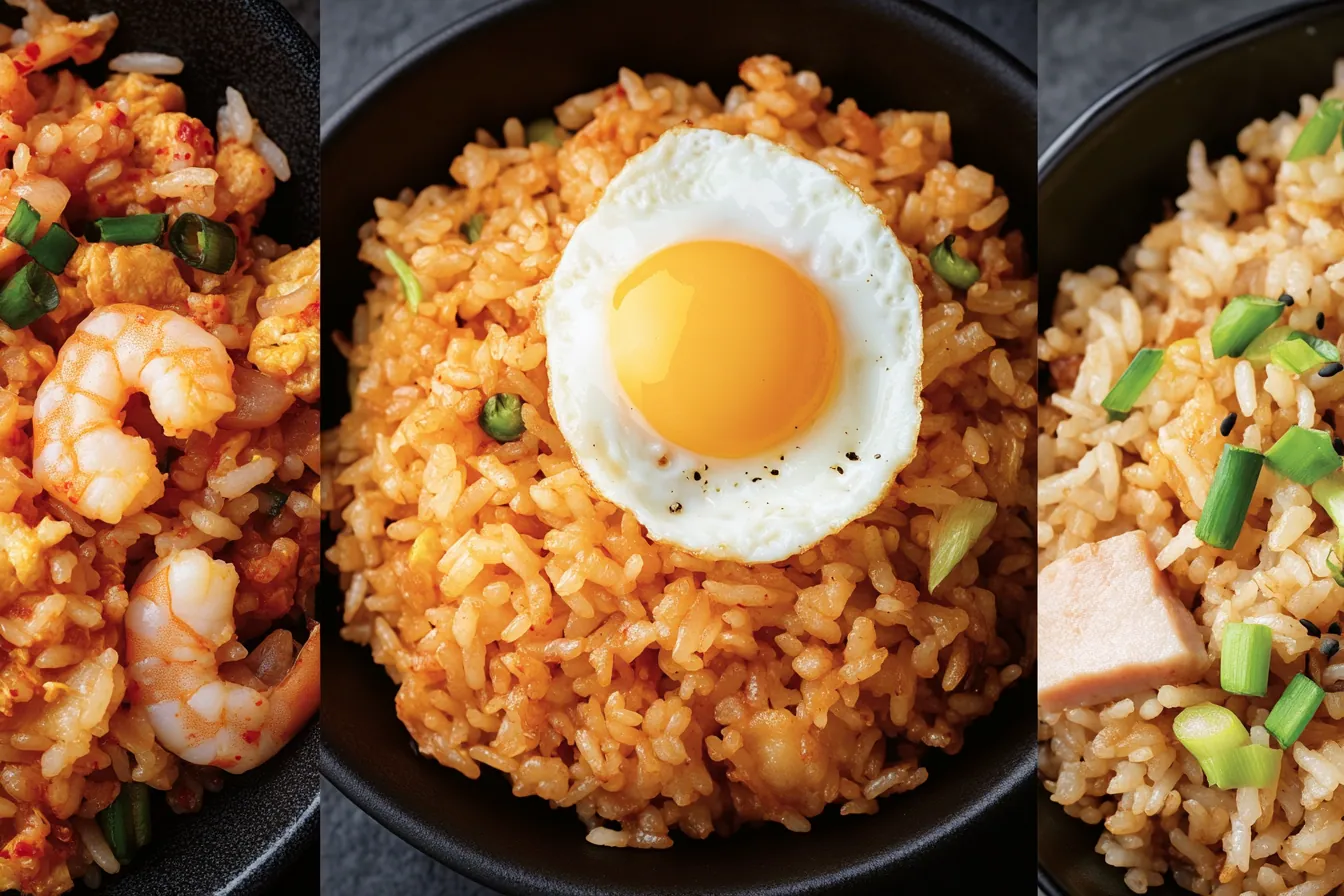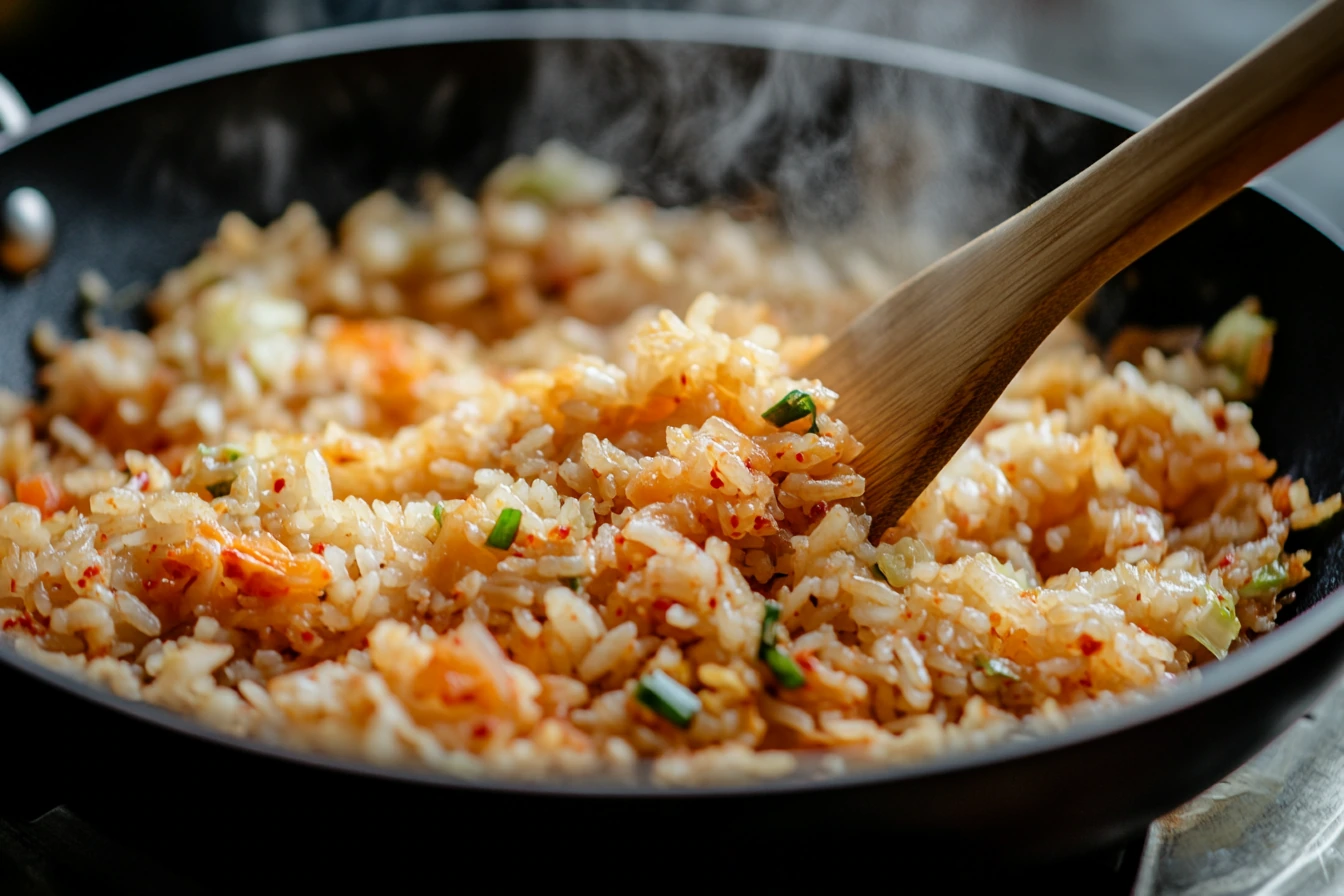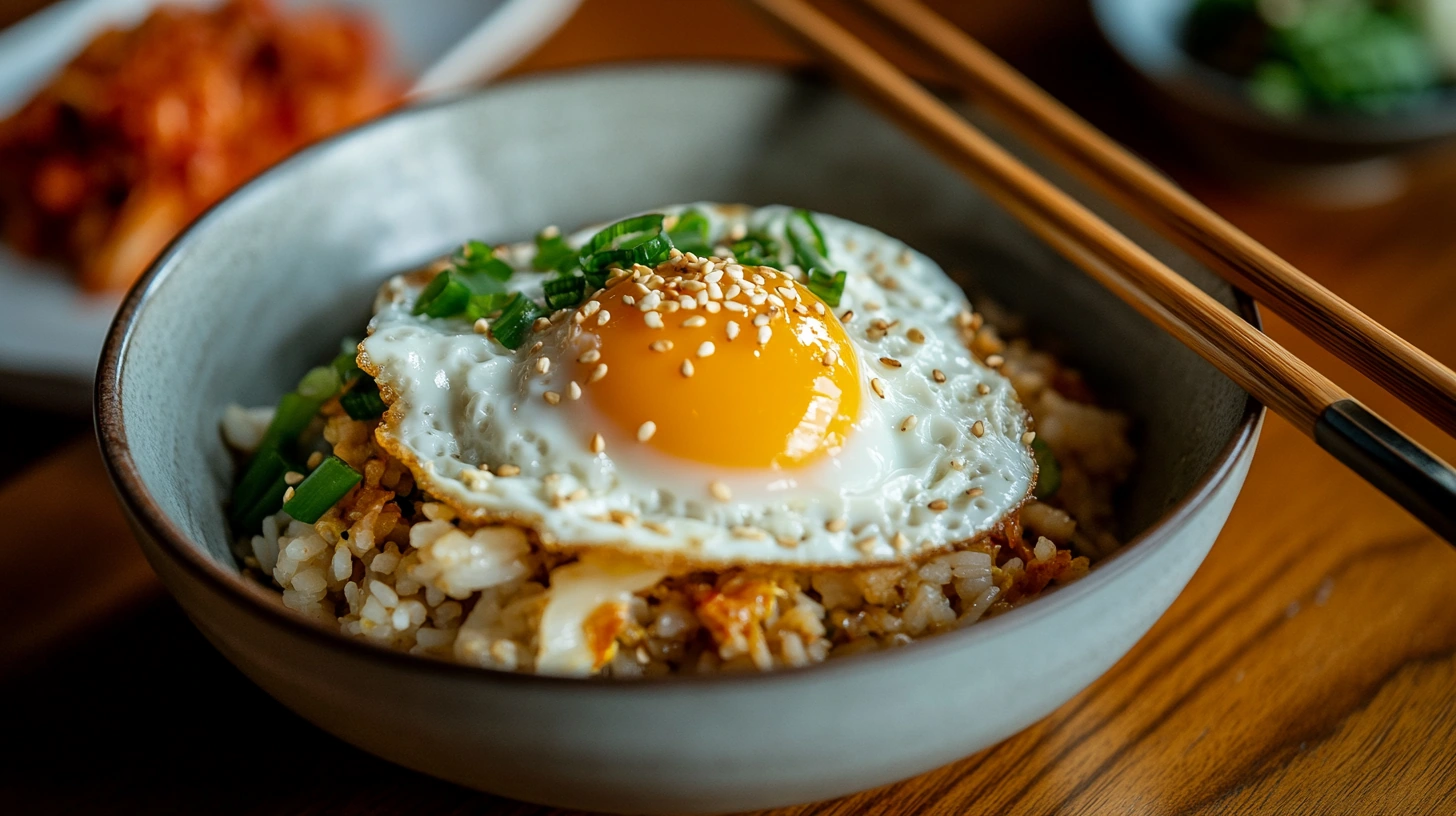Kimchi fried rice is a bold, flavorful dish loved for its spicy, tangy, and umami-rich profile. It’s a staple in Korean cuisine, known for combining fermented kimchi, rice, and seasonings into a delicious, one-pan meal. Whether you enjoy spicy foods or prefer something with deep, savory notes, this dish delivers a perfect balance of heat and richness.
In this guide, we’ll explore the taste, texture, and key ingredients that make it unique. We’ll also share tips for making the best version at home and how it compares to other fried rice varieties.
In This Article
The Taste Profile of Kimchi Fried Rice
What is Kimchi Fried Rice?
Kimchi fried rice (kimchi-bokkeumbap) is a staple in Korean cuisine, often made as a quick meal using leftover rice and aged kimchi. It’s simple yet packed with flavor, thanks to the natural fermentation of kimchi and the savory seasonings that go into it. The dish is typically stir-fried with ingredients like gochujang (Korean chili paste), sesame oil, soy sauce, and egg, creating a dish that’s both satisfying and easy to prepare.
But what does kimchi fried rice taste like exactly? Let’s break it down.
Primary Flavor Notes: Spicy, Tangy, and Umami
Kimchi fried rice is all about balance. The first thing you’ll notice is the spicy kick from the chili-infused kimchi, which gets even bolder if gochujang is added. But it’s not just heat—there’s also a tangy, slightly sour note that comes from the fermented kimchi, giving the dish a deep, almost pickled complexity.
Then comes the umami punch. Ingredients like soy sauce, garlic, and sesame oil bring out that rich, savory goodness, while the fried egg on top adds a creamy contrast that ties everything together. If you let the rice crisp up in the pan, you’ll also get a hint of toasty, smoky undertones, adding even more depth.
Texture: Crispy, Soft, and Hearty
The texture of kimchi fried rice is just as exciting as its flavor. Depending on how it’s cooked, you’ll experience:
- Soft, fluffy rice infused with bold flavors
- Crunchy bits of caramelized rice from the pan-frying process
- Chewy kimchi pieces that give each bite a nice contrast
- Silky smooth egg yolk (if topped with a fried or soft-boiled egg)
This mix of soft, crispy, and chewy textures makes every bite interesting and satisfying. No two spoonfuls taste exactly the same, thanks to the layered flavors and textures throughout the dish.
How Kimchi Influences the Taste of Fried Rice

Fermentation and Its Impact on Flavor
The magic behind kimchi fried rice lies in its main ingredient—kimchi. Because kimchi is fermented, it develops a deep, tangy, slightly sour taste over time. The longer it ferments, the more intense the flavors become. When stir-fried with rice, the tanginess balances out the richness of oils, eggs, and other seasonings, creating a well-rounded dish.
The fermentation process also brings a natural umami flavor, making kimchi fried rice extra savory and addictive. That’s why older, well-fermented kimchi works best—it has a more concentrated taste, making the fried rice bolder and more flavorful.
Difference Between Fresh and Aged Kimchi
Not all kimchi is the same! Fresh kimchi, often eaten within a few days of making it, has a crunchy texture and a mild, slightly sweet taste. When used in fried rice, it results in a lighter, fresher flavor.
On the other hand, aged kimchi has had more time to ferment, meaning it’s stronger, tangier, and more pungent. This is what gives kimchi fried rice its signature deep flavor. Many Korean households even keep separate jars of kimchi—one for fresh eating and one for cooking.
How Kimchi Juice Enhances the Dish
Never throw away kimchi juice! The leftover brine from fermented kimchi is liquid gold when making fried rice. A few spoonfuls can:
- Enhance the spicy, tangy, and umami flavors
- Give the rice a rich, reddish color
- Add moisture, helping the ingredients blend perfectly
If you love an extra kick of flavor, stir in a bit of kimchi juice while cooking. It makes a huge difference!
Key Ingredients That Shape the Taste
Gochujang and Other Korean Spices
Beyond kimchi, seasonings play a big role in the taste of kimchi fried rice. One of the most common ingredients is gochujang, a Korean chili paste that adds:
- A deep, smoky spice
- A hint of sweetness
- Extra umami richness
Other essential spices include garlic, sesame oil, and soy sauce, all of which contribute to the dish’s savory, slightly nutty, and aromatic taste.
Rice: The Foundation of the Dish
The type of rice you use greatly impacts the final texture. The best choice is day-old, short-grain rice, which is slightly sticky but firm enough to absorb flavors without getting mushy. Freshly cooked rice can work too, but letting it sit in the fridge overnight helps it firm up, making it perfect for frying.
Toppings and Garnishes: Egg, Sesame, and More
Kimchi fried rice is delicious on its own, but adding toppings takes it to the next level:
- Fried egg – The creamy yolk balances the spice and adds richness.
- Sesame seeds – Adds a light, nutty crunch.
- Green onions – Provides a fresh, slightly sweet contrast.
- Seaweed strips (gim) – Enhances the umami flavor.
Want to try a meatier version? Check out this Kimchi Chicken Fried Rice Recipe for a protein-packed twist!
Comparing Kimchi Fried Rice to Other Fried Rice Varieties

Kimchi Fried Rice vs. Chinese Fried Rice
At first glance, kimchi fried rice and Chinese fried rice might seem similar, but their flavors are vastly different. Chinese fried rice is usually seasoned with soy sauce, oyster sauce, and garlic, creating a mild, savory taste with a hint of sweetness. It often contains diced vegetables, eggs, and sometimes shrimp, chicken, or pork.
On the other hand, what does kimchi fried rice taste like compared to Chinese fried rice? It’s much bolder and spicier, thanks to the fermented tang of kimchi and the deep heat from gochujang or red pepper flakes. The absence of soy sauce allows the natural umami from kimchi and sesame oil to shine.
Kimchi Fried Rice vs. Japanese Chahan
Japanese chahan (fried rice) is typically milder and relies on bonito flakes, dashi, or soy sauce for its umami depth. It’s often less oily than Chinese fried rice and includes ingredients like ham, green onions, and egg. In contrast, kimchi fried rice packs a punch, offering a more intense, spicy, and slightly sour taste.
Fusion Variations: Western and Vegan Adaptations
Kimchi fried rice has also inspired fusion variations. Some Western versions add cheese, making it creamier and less spicy, while vegan versions swap eggs for tofu or plant-based alternatives. If you’re looking for a delicious variation, check out this Kimchi Chicken Fried Rice Recipe for a protein-packed twist!
FAQs – What People Also Ask
1. Is kimchi fried rice very spicy?
The spiciness of kimchi fried rice depends on the type of kimchi and whether extra chili paste (gochujang) or red pepper flakes are added. Traditional versions have a medium level of heat, but you can adjust the spice level by choosing milder or spicier kimchi. Adding a fried egg also helps mellow the spice.
2. What does kimchi fried rice taste like compared to plain fried rice?
Kimchi fried rice is much bolder, tangier, and spicier than plain fried rice. The fermented kimchi gives it a deep umami richness, while the chili seasoning adds a warm, lingering heat. Compared to plain fried rice, it’s more complex, savory, and slightly sour due to the fermentation process.
3. Can you make kimchi fried rice less sour?
Yes! If your kimchi is too sour, try stir-frying it with a bit of sugar to balance out the acidity. You can also mix in cheese, eggs, or a splash of cream to soften the tangy taste. Using fresh (less fermented) kimchi instead of aged kimchi will also result in a milder flavor.
4. What protein pairs best with kimchi fried rice?
Common protein choices include:
Fried eggs – The rich yolk balances out the spice.
Spam or bacon – Adds a smoky, salty contrast.
Chicken or tofu – A leaner, lighter option that soaks up the flavors.
For a meatier version, check out this Kimchi Chicken Fried Rice Recipe!
Tips for Making the Best Kimchi Fried Rice at Home

Use Aged Kimchi for Maximum Flavor
When making kimchi fried rice, the type of kimchi you use makes a huge difference. Fresh kimchi has a crisp texture and mild flavor, but if you want that deep, tangy, umami kick, go for aged kimchi (kimchi that has fermented for at least 2-3 weeks). The longer it ferments, the stronger the flavors get, making the dish bolder and richer.
Day-Old Rice is the Secret to Perfect Texture
If you’ve ever wondered what does kimchi fried rice taste like when made with fresh vs. leftover rice, here’s the answer: day-old rice is always better. Freshly cooked rice contains too much moisture, making it soft and sticky when stir-fried. Leftover rice, on the other hand, has dried out slightly, allowing it to absorb flavors while keeping a light, chewy texture.
Don’t Skip the Kimchi Juice
Kimchi juice is packed with fermented chili, garlic, and umami goodness. Adding just a few spoonfuls while frying your rice:
- Enhances the tangy, spicy profile
- Adds a beautiful reddish-orange color
- Helps blend the flavors together smoothly
Finish with a Fried Egg and Sesame Oil
A runny fried egg on top of kimchi fried rice is a game-changer. The creamy yolk balances out the heat and gives the dish a rich, velvety texture. A drizzle of sesame oil at the end adds a nutty aroma, making each bite even more flavorful.
Final Thoughts – Why You Should Try Kimchi Fried Rice
If you’ve never had it before, you might be asking, what does kimchi fried rice taste like and is it worth trying? The answer is a resounding yes! This dish is a perfect blend of bold, spicy, tangy, and savory flavors that come together in an irresistible way.
One of the best things about kimchi fried rice is how versatile and easy to make it is. Whether you like it mild or extra spicy, with bacon or tofu, or topped with cheese or seaweed, there’s a version for everyone. Plus, it’s a fantastic way to use up leftover rice and kimchi, making it a budget-friendly and zero-waste meal.
Beyond its incredible taste, kimchi fried rice is also packed with health benefits. Because kimchi is fermented, it’s loaded with probiotics that promote gut health. It’s also rich in vitamins A, C, and K, and when paired with protein (like eggs, chicken, or tofu), it becomes a well-balanced meal.
Since kimchi is packed with probiotics, it supports gut health and digestion (National Center for Biotechnology Information).
If you’re a fan of bold, flavorful foods, kimchi fried rice is definitely a dish worth adding to your list. It’s easy to make, incredibly delicious, and offers a unique twist on traditional fried rice. So why not give it a try?

